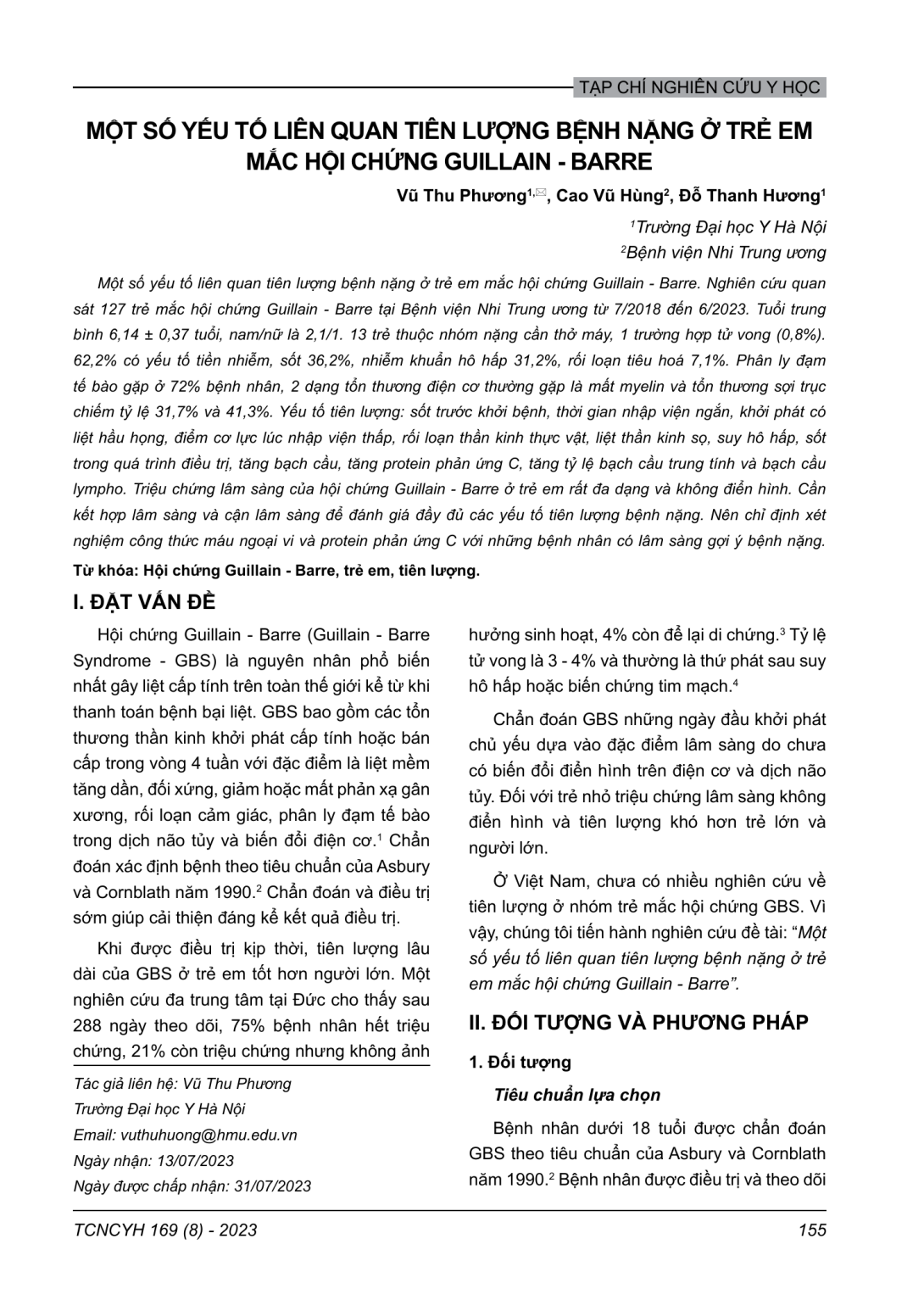
Một số yếu tố liên quan tiên lượng bệnh nặng ở trẻ em mắc hội chứng Guillain - Barre. Nghiên cứu quan sát 127 trẻ mắc hội chứng Guillain - Barre tại Bệnh viện Nhi Trung ương từ 7/2018 đến 6/2023. Tuổi trung bình 6,14 ± 0,37 tuổi, nam/nữ là 2,1/1. 13 trẻ thuộc nhóm nặng cần thở máy, 1 trường hợp tử vong (0,8%). 62,2% có yếu tố tiền nhiễm, sốt 36,2%, nhiễm khuẩn hô hấp 31,2%, rối loạn tiêu hoá 7,1%. Phân ly đạm tế bào gặp ở 72% bệnh nhân, 2 dạng tổn thương điện cơ thường gặp là mất myelin và tổn thương sợi trục chiếm tỷ lệ 31,7% và 41,3%. Yếu tố tiên lượng: sốt trước khởi bệnh, thời gian nhập viện ngắn, khởi phát có liệt hầu họng, điểm cơ lực lúc nhập viện thấp, rối loạn thần kinh thực vật, liệt thần kinh sọ, suy hô hấp, sốt trong quá trình điều trị, tăng bạch cầu, tăng protein phản ứng C, tăng tỷ lệ bạch cầu trung tính và bạch cầu lympho. Triệu chứng lâm sàng của hội chứng Guillain - Barre ở trẻ em rất đa dạng và không điển hình. Cần kết hợp lâm sàng và cận lâm sàng để đánh giá đầy đủ các yếu tố tiên lượng bệnh nặng. Nên chỉ định xét nghiệm công thức máu ngoại vi và protein phản ứng C với những bệnh nhân có lâm sàng gợi ý bệnh nặng.
We conducted a survey research on 127 children with Guillain - Barre syndrome at the National Children's Hospital from 7/2018 to 6/2023 to investigate severe prognosis factors associated with this condition. The mean age was 6.14 ± 0.37 years old (16 months - 16 years old), male/female ratio was 2.1/1. There were 13 patients in the severe group requiring mechanical ventilation, including 1 death (0.8%). 62.2% had pre - infectious factors, common were fever 36.2%, respiratory infections 31.1%, digestive disorders 7.1%. Cytoalbuminologic dissociation was found in 72% of patients, 2 common types of electromyography were demyelination and axonal degeneration for 31.7% and 41.3%. Prognosis of severe disease were pre - infection with fever, short day of presentation, oropharyngeal weakness at onset, low muscle strength score at admission, autonomic dysfunction, cranial nerve palsy, respiratory failure, fever during treatment, increased leucocyte count, increased C - reactive protein and increased neutrophil lymphocyte ratio. Clinical symptoms of Guillain - Barre syndrome in children are various and atypical thus it is necessary to combine clinical and laboratory studies to fully evaluate the severe prognostic factors of the disease. Peripheral blood count and C - reactive protein testing should be indicated in patients with clinical findings suggestive of severe disease.
- Đăng nhập để gửi ý kiến
